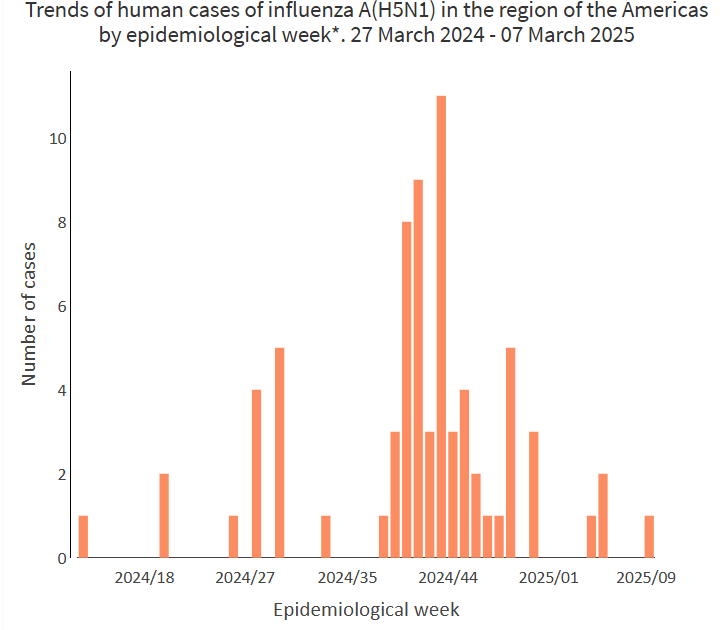#18,721
It's been just over 2 months since the last epidemiological update on H5N1 was published by PAHO (the Pan American Health Organization), and while the number of of new cases reported by the United States has slowed, the threat has not gone away.
In April, we saw Mexico Report their 1st Human H5N1 Case in a 3-year old girl from (largely agricultural) Durango State, and a couple of weeks later we looked at WHO Guidance: Surveillance for Human Infections with Avian Influenza A(H5) Viruses which urged member nations to step up surveillance and reporting.
How much testing, and sharing of information, is really going on is difficult to say.
While the 2005 IHR agreement requires nations to report certain disease outbreaks and public health events to the WHO in a timely manner, this goal has long been hampered by a lack of any enforcement options in the agreement (see Adding Accountability To The IHR).
Last March, in Nature: Lengthy Delays in H5N1 Genome Submissions to GISAID, we learned that the average delay for submitting non-human sequences was 7 months, and that Canada came in last at 20 months.
I've only posted the link and some excerpts from the 12-page PDF report. Follow the link to read it in its entirety.
Epidemiological UpdateAvian Influenza A(H5N1)in the Americas Region15 May 2025
Global Context
In 2020, the highly pathogenic avian influenza (HPAI) virus1 subtype H5N1 of clade 2.3.4.4b caused an unprecedented number of deaths in wild birds and poultry in numerous countries in Africa, Asia, and Europe (1). In 2021, this virus spread through major waterfowl flyways to North America and, in 2022, to Central and South America (1). By 2023, outbreaks in animals were reported from 14 countries and territories, mainly in the Americas (1, 2).
In recent years, there has been an increase in the detection of the influenza A(H5N1) virus in non-avian species worldwide, including terrestrial and marine mammals, both wild and domestic (companion and production). Since 2022, 22 countries on three continents, including the Americas, have reported outbreaks in mammals to the World Organisation for Animal Health (WOAH) (3).
Historically, since the beginning of 2003 and as of 22 April 2025, 973 human cases of avian influenza A(H5N1), including 470 deaths (48% case fatality rate), were reported to the World Health Organization (WHO) from 25 countries globally (4).
Summary of the situation in the Americas Region
Since 2022 and as of epidemiological week (EW) 18 of 2025, a total of 19 countries and territories2 in the Americas Region reported 4,948 animal outbreaks3 of avian influenza A(H5N1) to WOAH (3), representing 235 additional outbreaks since the last epidemiological update on avian influenza A(H5N1) published by the Pan American Health Organization/World Health Organization (PAHO/WHO) on 4 March 2025 (3, 5).
Since 2022 and as of 12 May 2025, 75 human infections caused by avian influenza A(H5) have been reported in five countries in the Americas, with one additional case reported since the 4 March 2025 PAHO/WHO epidemiological update on avian influenza A(H5N1) (Figure 1) 6).
The most recent human case of avian influenza A(H5N1) reported in the Americas Region was reported in Mexico on 2 April 2025 (6-8), 71 cases have been reported in the United States of America – one in 2022 and 70 since 2024 (9), one case in Canada was confirmed on 13 November 2024 (10), one case in Chile was reported on 29 March 2023 (11), and one case in Ecuador was reported on 9 January 2023 (12).
(SNIP)
PAHO/WHO urges Member States to work collaboratively and in an intersectoral manner to preserve animal health and protect public health. It is essential that preventive measures for avian influenza be implemented at the source, protocols for detection, notification and rapid response to outbreaks in animals be established, surveillance for both animal and human influenza be strengthened, epidemiological and virological investigations be carried out in relation to animal outbreaks and human infections, genetic information about viruses be shared, thereby fostering collaboration between animal and human health settings, effectively communicating risk , and ensuring preparedness for a potential influenza pandemic at all levels (30, 31).

